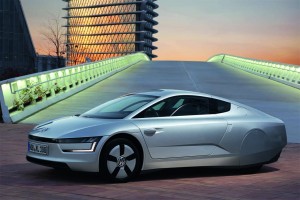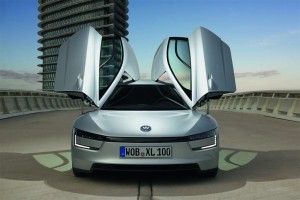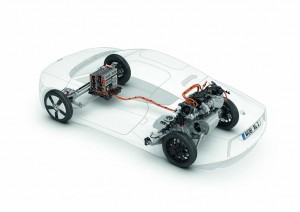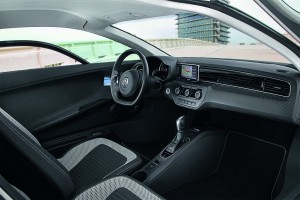Volkswagen plans to launch what it is billing as the world’s most fuel-efficient production car, the plug-in XL1 expected to yield a combined fuel economy rating of 261 miles per gallon.
The gas-electric 2-seater also will get an estimated 32 miles per charge in all-electric mode, according to VW. It will nonetheless be able to hit a top speed of 99 mph.
The XL1 is the latest design to emerge from an ongoing project designed to see just how far VW can stretch a gallon of gas. The original goal was to use just one liter of fuel to travel 100 kilometers. That would have worked out to 235 mpg in American terms. The XL1 beats that by more than 10 percent.
It also more than doubles the current U.S. mileage champ, he Scion iQ EV, which gets 121 MPGe, or miles per gallon equivalent, a conversion used for plug-in hybrids and pure battery-electric vehicles.
That means the VW XL1 will get nearly five times the 54.5 miles per gallon average that the Obama Administration has called for under the revised Corporate Average Fuel Economy, or CAFE, standard to go into effect in 2025. (In fact, because of various caveats and exemptions in the CAFE mandate, the average U.S. vehicle would only have to deliver something in the mid-40 mpg range.)
The XL1’s 261 mpg number itself is based on European testing procedures and that is likely to mean a moderate reduction if it were put through the tests used in the U.S. by the Environmental Protection Agency. Nonetheless, it is substantially better than any vehicle now on the road.
To get there, Volkswagen designers and engineers have taken a number of critical steps:
- They’ve used carbon fiber and other super-light body and chassis material to bring the XL1’s total mass down to just 1753 pounds – or about 1,000 pounds less than the 2-seat Honda CRZ;
- The wind-cheating design of the VW plug-in includes covers over the rear wheels and a sealed underbody, achieving aircraft levels of aerodynamic drag. The XL1 could cruise down a freeway on the power produced by a medium-sized lawnmower;
- The powertrain is comprised of a pint-sized, 47-hp 2-cylinder turbodiesel of only 0.8 liter displacement, mated to a 27 hp electric motor. They’re linked to the wheels through a 7-speed double-clutch automatic gearbox.
The hybrid drivetrain uses a modest size lithium-ion battery pack. Though VW doesn’t provide details it is likely capable of storing somewhere between 10 and 15 kilowatt-hours of energy.
The XL1 is the third vehicle to emerge from VW’s so-called “1-liter strategy,” and apparently the most conventional, if that term applies to a vehicle that could travel nearly from New York to Boston on a single gallon of fuel.
In the earlier L1 prototype, driver and passenger sat in a tandem arrangement. In the XL1 they are slightly offset though sit side-by-side.
The vehicle wouldn’t appeal to performance fans, taking a full 12.7 seconds to get from 0 to 60 mph.
To put it into perspective, the new model is about the length of Volkswagen European subcompact, the Polo – the XL1 measures 153.1 inches nose-to-tail, and 65.6 inches wide compared to the Polo’s dimensions of 156.3 inches by 66.2 inches. The XL1 is also lower, at 45.4 inches compared to the more conventional models 57.6-inch height.
Beyond the aerodynamic cladding, one of the new mileage champ’s most distinctive features is the use of gull-wing doors, a design detail normally found on only a few of the world’s most expensive sports cars.
Like other battery-based vehicles, the XL1 is almost certain to carry a significant price premium for all the new technology, including the materials designed to reduce its weight, as well as the gas-electric drivetrain.
It’s unclear, as well, what markets the VW XL1 will be offered in, though the miniscule size and relatively laggard performance appear to have ruled it out of the maker’s U.S. line-up for now — though the maker eventually might want to bring it over as a showpiece in the battle to prove which manufacturer can claim to be the greenest.
VW will give the media and public a first look at the XL1 – and likely provide more details — during next month’s Geneva Motor Show.





As chap whose first car was an AH-100 in 1959, I’ve owned or driven everything from Fiat 750cc Abarths to Zagatos (take your pick). This machine reminds me of some of the early Le Mans performance of energy entrants at the 24 Hr race. My 2 Abarths and my 2 Lotus’s were/are smaller lighter and some are faster than the XL1. That said, I’d have this in my stable right between my MG TC and my C6 Vette. Because I like technology that pushes the limits and hell, this is a great town driver. One question, how is it’s hill climbing performance, a 55 hp 750 Abarth on a long 6%+ grade will end up in 2nd gear and slowed to less than 30mph.
Sadly, C6, I have no idea how the XL1 will drive. We will be pressing VW hard for that opportunity as soon as they’re able to get us behind the wheel.
Paul A. Eisenstein, Publisher, TheDetroitBureau.com
Like the not so smart car, these motorcycle engine power cars are only practical for city use IME. They are dangerous in suburban areas where you need to accelerate up to speed to enter freeways or even 50 mph local roadways.
In Germany I have seen a line of cars behind a not so Smart car as it drove along at 50 kph on a 100 kph road in a rural area. The driver is lucky he wasn’t shot…
In the US he would have been.
Paul E.
The bigger question is how much will it cost? Will it be reasonable or something only a person rich enough not to think about the price of gas can afford (i.e. Tesla)
We’ve yet to hear but don’t expect it to come cheap with all that technology, including extensive use of carbon fiber. We hope to learn more during the preview in Geneva.
Paul A. Eisenstein
Publisher, TheDetroitBureau.com